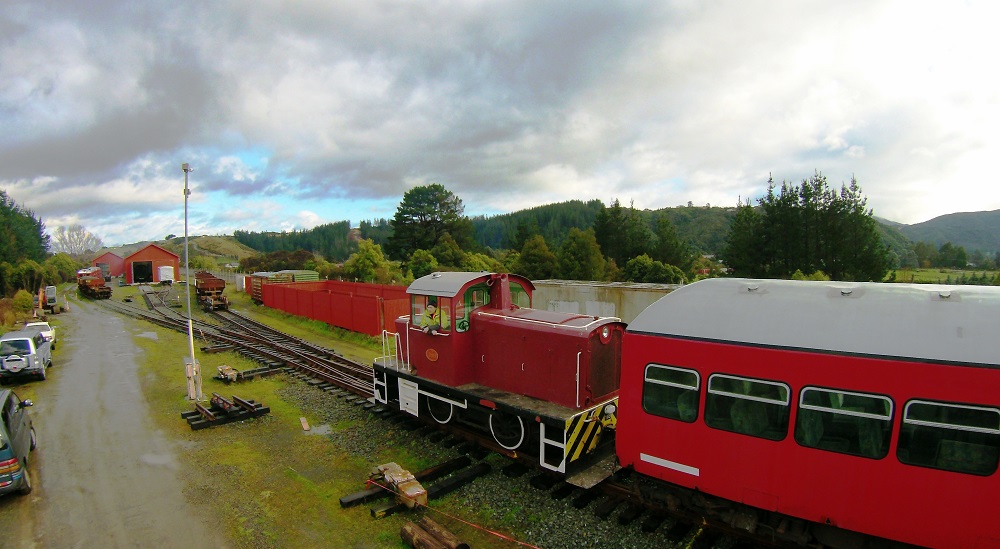
Panorama view of Tr189 on a train service at Maymorn, mid 2015. Photo: Grant Morrell.
24 November 2016
Chairperson's Report
The predominant physical project work for the Trust during 2015-2016 were focused on developing railway facilities at Maymorn, 6km northeast of Upper Hutt. In the future this will be the departure point for heritage train services that the Trust proposes to operate over the former railway route between Upper Hutt and Featherston. Maymorn station is ideally situated, connected to Upper Hutt, Wellington and the Wairarapa via current Tranz Metro passenger services, and only a short distance from the heritage railway route proper.
Facilities at Maymorn currently under development, whilst currently required for the construction phase, will be used without modification for the future railway operation. For example, the rail vehicle shed will eventually be used to store operational locomotives and carriages, and initial railway track being built will become our future mainline at the station building. Significant milestones were achieved for the rail vehicle shed during the year: completion of the main roof structure, installation of train doors and pedestrian doors — which means that we now have a secure facility. Train services and workshop tours are a feature of our monthly operating days, where we present local railway heritage to the public at the Maymorn site.
Developments at Maymorn
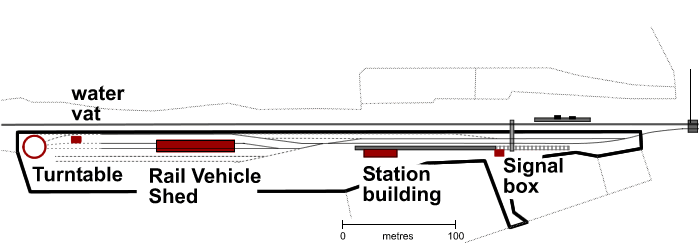
The Maymorn operational base is important in a number of ways. It is the current focus of volunteer activity, which the Trust is entirely reliant upon for its future. Tranz Metro Wairarapa Line passenger services service Maymorn, which provides connection to and from Wellington, the Hutt Valley and the Wairarapa — and strategically, a future life-line for tourist visitation to the railway. The facilities under construction at Maymorn will protect the Trust’s current rail vehicle fleet, and facilitate their future restoration, operation and maintenance. Plans have also been prepared and resource consent approved for a large station building incorporating a visitor centre, historic and interpretative displays, and a cafe. These facilities will play a central role in the Trust’s future operations, being the departure point for a journey back in time over the historic Rimutaka Incline.
Train Operations
We have been offering train rides for the public at Maymorn since 2 October 2013, initially with cab rides in our shunting locomotive and jigger rides, 11 May 2014 started locomotive-hauled train services, catering for around 40 people at a time with one of the trailer cars that made up the 'Cyclops' electric multiple unit set.
We have continued to offer short rides in our station yard through the year, with a number of exhibits available for viewing in the rail vehicle shed.
Entry tickets are sold at the gate at $5 per person or $15 for a family ticket for up to four rides per ticket along with tours of the rail vehicle shed.
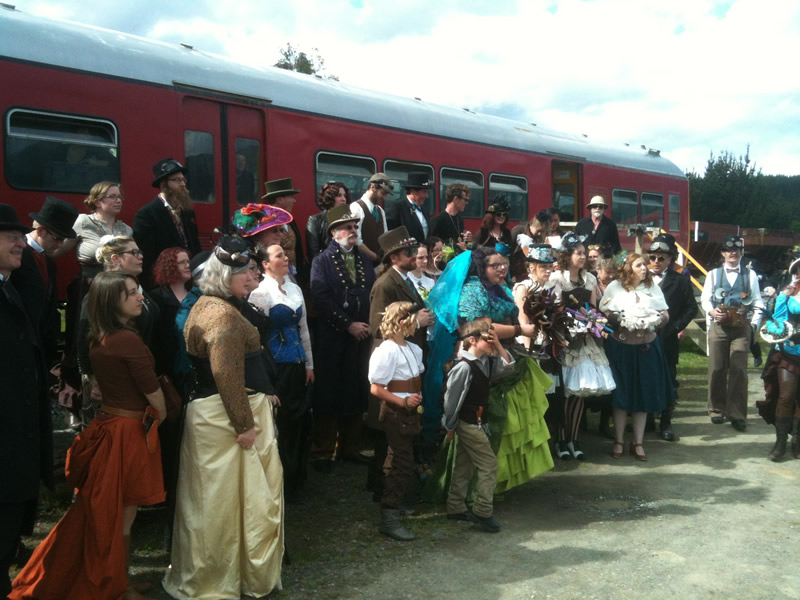
Labour Weekend 2015 - Cat and George had their epic Steampunk Wedding, the first charter for the railway.
Visiting rail vehicle
A trial run of rubber-tyred 3-man motor trolley #7002 was made at Maymorn on 30 May 2016, The NZRLS-owned trolley has been restored to operating order by Ray Randle. After pre-run inspection checks and sign-off the trolley was gradually coaxed back to life. Some minor adjustments were needed to the Briggs and Stratton motor and gear lever, but otherwise it performed well.
More than seventy trolleys were to this 1961-design, having a lightweight aluminium alloy frame, rubber tyres and aluminium guide wheels. No. 7002 sports brackets on the left-hand side for carrying ladders, and would have been used by a signal maintainer. Trolleys of this type were commonly seen operating in the Wairarapa.
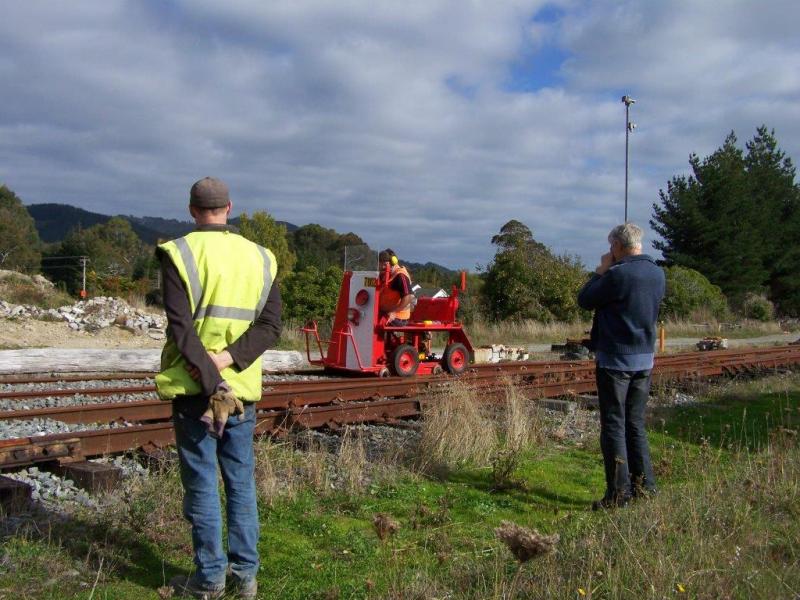
Visiting 3-man motor trolley #7002 making a trial run at Maymorn on 30 May 2016. Photo: WG Bennett.
Rail Vehicle Shed
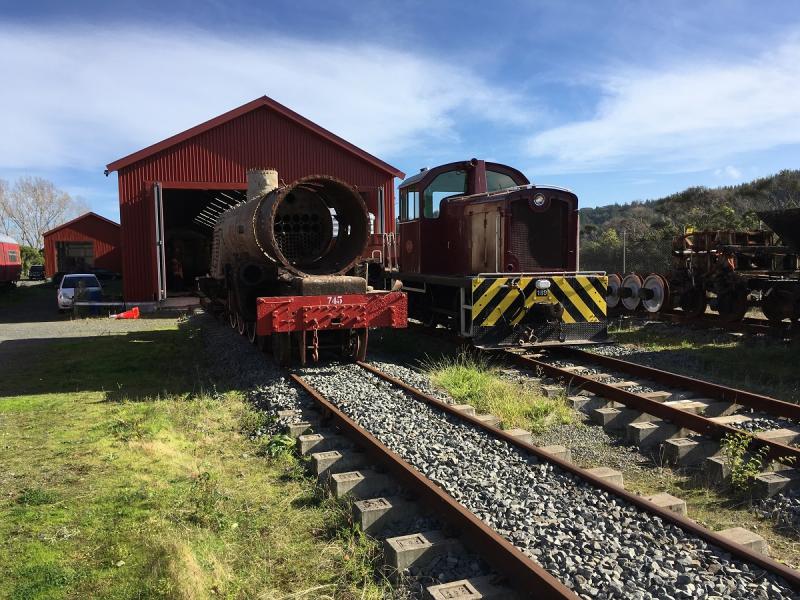
Ab 745 and Tr 189 stand outside the Maymorn rail vehicle shed.
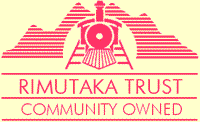
The rail vehicle shed at Maymorn has been the primary project for the Trust over the last seven years. A huge amount of design work, engineering consultation, planning and project management has gone into the structure. The vast majority of the foundation work, component fabrication and final construction has been undertaken by volunteers working in their spare time. The decision to replicate an original 1911 New Zealand Railways 2-road engine shed design has paid dividends in that the Maymorn station has a real railway depot “feel” about it. The building will also complement future heritage railway operations.
We are indebted to Rimutaka Charitable Trust for their continued support for the project, with considerable funding put into the rail vehicle shed in particular.
Workshop
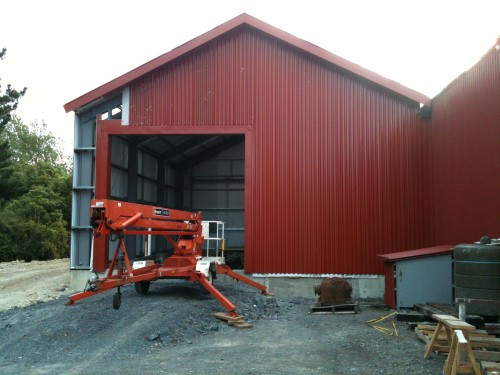
Exterior of the workshop, nearing the end of cladding installation, early 2015.
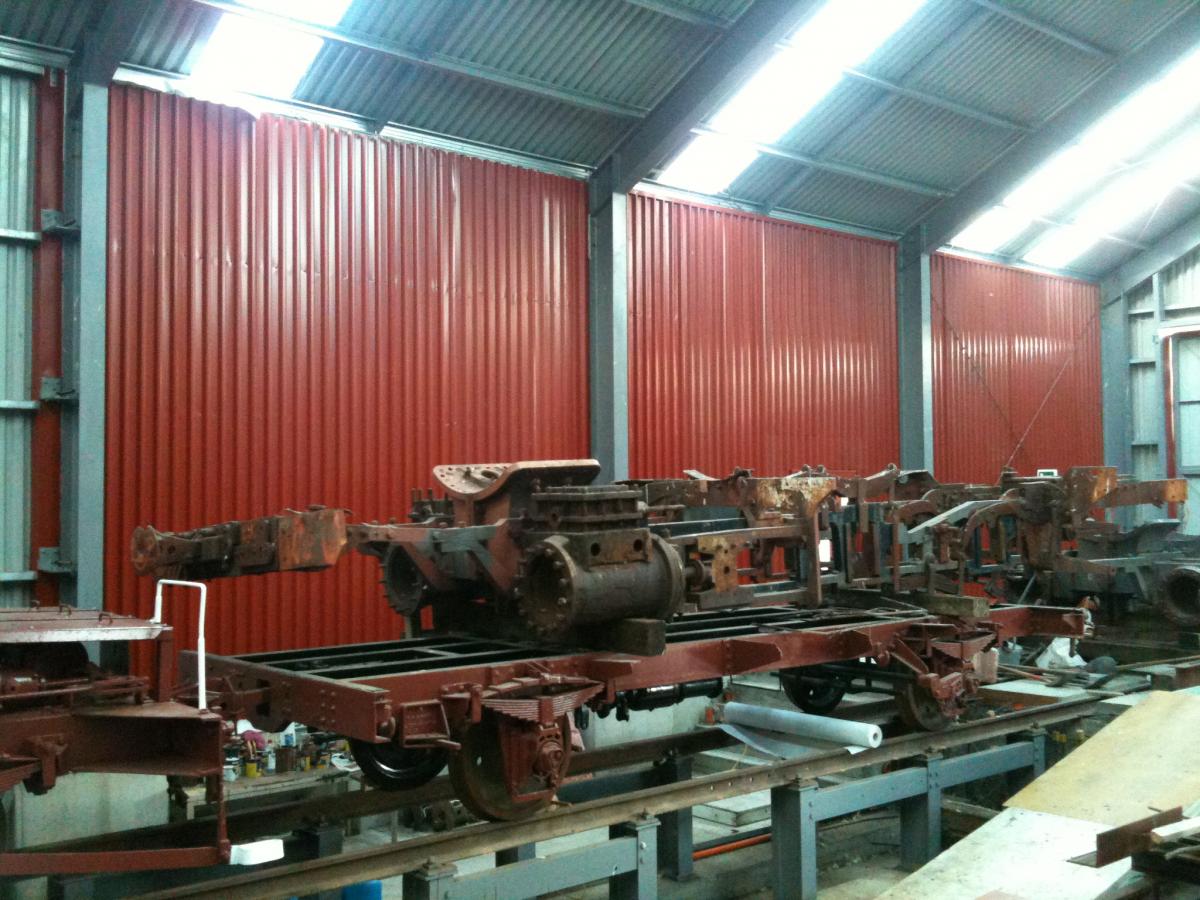
Insulated interior wall between workshop and main shed. Steam locomotives like the one pictured (Wb 292) and other rail vehicles will benefit from the workshop facilities being built.
Whilst the exterior shell of the rail vehicle shed nears completion, attention has also been put into constructing future servicing facilities and a workshop extension attached to the south. The 15-metre long workshop structure is of similar design to the rail vehicle shed and gives the appearance of a 4-road engine shed when viewed end-on. The rationale for the workshop is to provide space for a machine shop for future restoration and maintenance of locomotives, carriages and wagons.
There is a window of opportunity to efficiently construct the workshop, dovetailing onto structural work associated with the rail vehicle shed. Volunteers are experienced with the required building work. The workshop is also a condition of the Trust’s Resource Consent for rail activities at Maymorn.
Track
Building our mainline track through the Maymorn yard towards Kaitoke is a tangible step we can make at this early stage in the railway’s development. The extent of the work achieved has been possible due to a great deal of support from the rail civil engineering industry. We are also fortunate to have Trust members skilled in both project management and track construction to plan and carry out this work. The extension of our future mainline track through the Maymorn station is helping to transform the current construction site into an operational base for our railway.
Major donations of track materials received from KiwiRail and Holcim (New Zealand) Limited have been used to extend the mainline at Maymorn station.
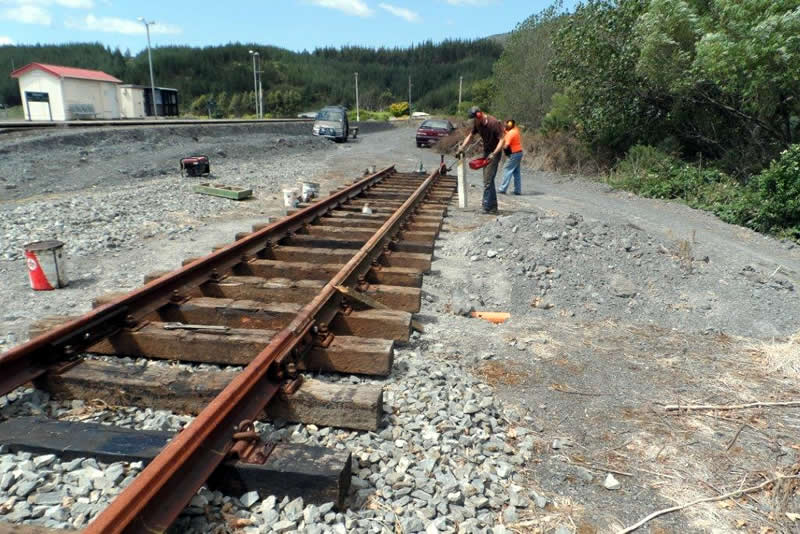
Our mainline being extended northwards past Maymorn station.
Rail licence
The Trust has been a licenced rail operator and rail network provider since 26 June 2009. Operations have continued through the 2015-2016 year, which saw the Trust complete its first external annual safety assessment carried out by the New Zealand Transport Agency.
Thanks and acknowledgements
I would like to acknowledge and thank the Trustees for their substantial commitment to Rimutaka Incline Railway vision, and Trust members and friends who continue to support the railway both through donations and thousands of hours of voluntary effort per year. The Trust’s achievements to date have only been possible through their dedication and support.
Ben Calcott
Chairperson
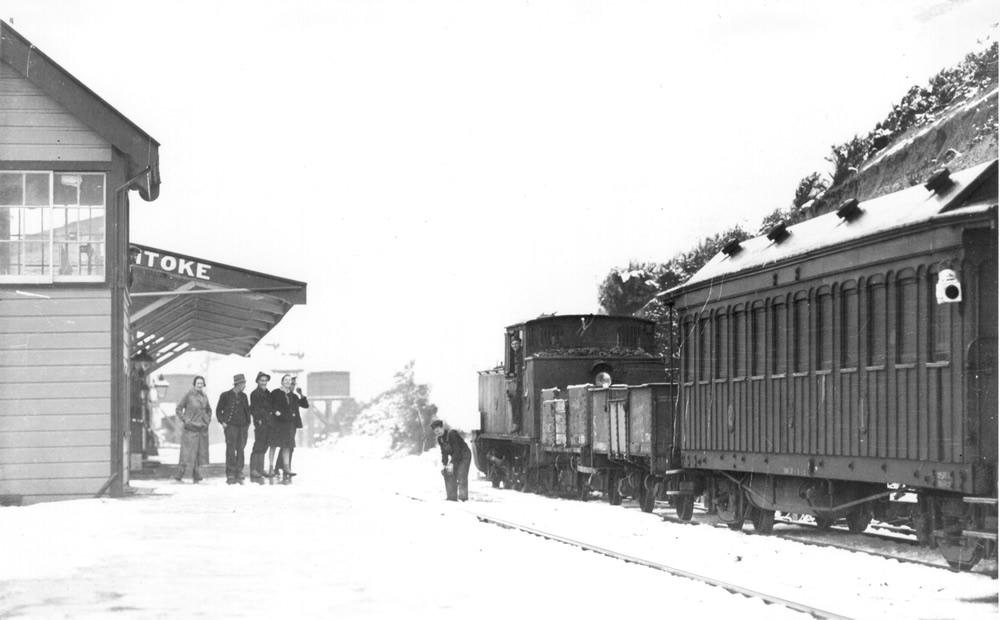
A Ww pauses in the loop at Kaitoke with a short mixed train, bound for Summit. Note the gorgeous Wairarapa-roofed Addington carriage at the rear of the train. These distinctive carriages were built at New Zealand Railway's Addington Workshops, Christchurch in the 1880's. A number of these carriages were fitted with "streamlining" over the elevated clerestory roof in deference to the strong winds encountered over the Rimutaka Incline and in the lower Wairarapa. The car is the last vehicle in the train—as evidenced by the tail lamp. Our plans for reinstating the station include replicas of all key structures, including the station building (including refreshment rooms), signal box, water vats and semaphore signals. Photo: Frank Teesdale collection.
Operational review
Operational management
The Trust’s activities and railway operation is managed through four committees:
- Railway Rebuild Committee: comprising Trustees and co-opted members, focussing on land-related issues — including requirements for returning to the heritage route proper, the connection route and general land issues.
- Fundraising and Promotions Committee: comprising Trustees and co-opted members, focussing on raising funds, financial management and promotion of the Trust.
- Rail Infrastructure Committee: comprises the General Manager/Rail Infrastructure Manager, Trustees and co-opted members, focussing on development of the Maymorn site, including railway track, buildings and services.
- Rail Vehicle Committee: comprises the General Manager, Rail Vehicle Manager, Trustees and co-opted members, focussing on the restoration and maintenance of rail vehicles.
- Operations Committee: comprises the General Manager/Operations Manager, Trustees and co-opted members, focussing on the safe operation of the railway.
The committees meet regularly through the year.
Land
The Trust continues to develop its operational base at Maymorn. We have a long-term lease of much of the former Maymorn railway yard from New Zealand Railway Corporation (trading as Ontrack / KiwiRail). It is an ideal location from which to commence the railway, having potential to connect with the Wairarapa railway line, and being in close proximity to the former heritage railway route.
Connection route
The connection route between Maymorn and the heritage formation leading towards Tunnel Gully has seen further work this year. Exploratory survey work was undertaken by Trust members, to a level sufficient to prove the feasibility of the alignment incorporated into the Maymorn Structure Plan (as discussed earlier in this report). Data obtained from the survey was used to model the landforms and property boundaries, and a route designed to make best use of the available landforms, conform to minimum curvature (100m radius) and maximum gradient (1 in 35) restrictions, and connect in with the KiwiRail corridor and the heritage railway formation respectively. Between all these design restrictions sufficient route length has been obtained to regain the heritage railway formation as it climbs towards Tunnel Gully. The route is at the limits of conventional railway design standards, consistent with the remainder of the heritage route to Kaitoke and Summit.
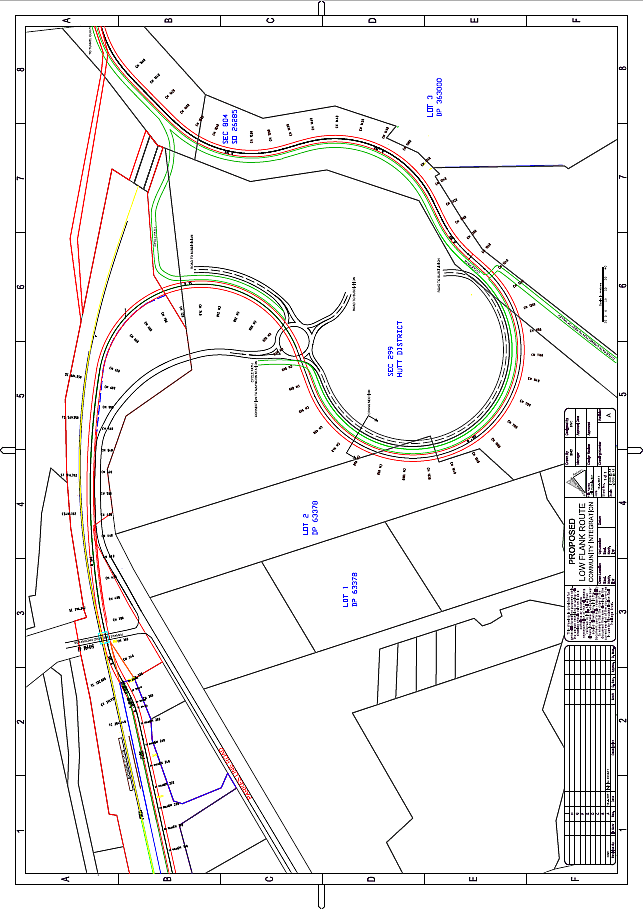
Proposed alignment of connection route climbing out of Maymorn, showing possible integration into a network of cycle / pathways, connecting into a walkway along the heritage railway formation that heads to the south up the Mangaroa Valley, and both railway and walkway connecting into Tunnel Gully.
Rail licence
As mentioned in the Chairperson’s report, the railway has been operating under a full rail licence since 26 June 2009. A high-level safety case documents the nature of the licensed rail activities, including risk analysis and other appendices, and a safety system, along with codes, standards, training documents and other incorporated items provide detail on systems, policies and procedures for the day-to-day operation.
The current extent of rail operations at the Maymorn site is rather limited, but most of the risks associated with larger operations are present and are managed in a professional manner. This lays the ground-work for safe operation of a more extensive operation.
Certifications
A number of rail personnel have been certified for a number of core duties, including Shunter, Shunt Driver, Locomotive Engineer, Train Inspector, Train Manager, Track Inspector and Track Maintainer.
Training
On-the-job training has been carried out during the year, with rail personnel constructing track, and maintaining rail vehicles under supervision.
Safety Assessment
An ordinary external safety assessment was carried out for New Zealand Transport Agency in April 2016, and the Trust undertook an internal safety assessment of our own rail operations in October 2015, both of which have been completed and closed out.
Track
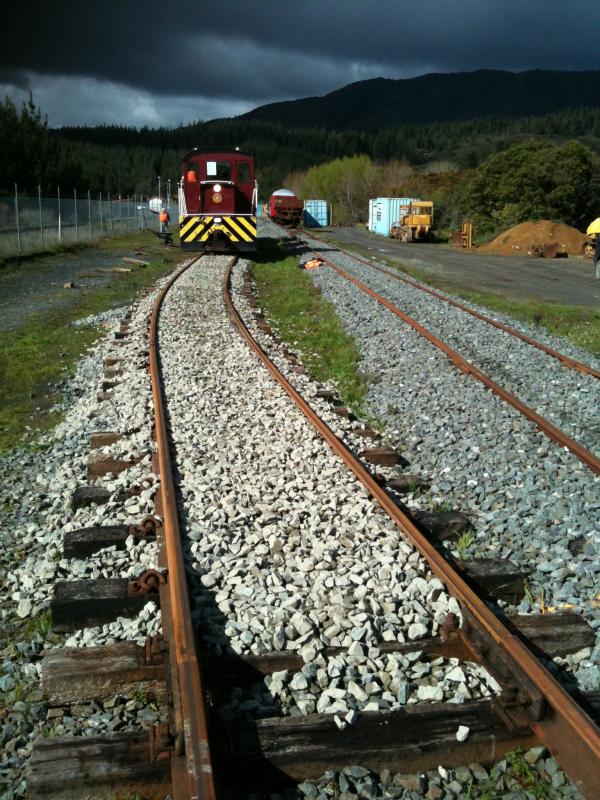
Loop track ballasting work in September 2015.
Significant progress has been made with track laying at the Maymorn site this year, work concentrating on starting our future mainline, whilst progress was also made with turnouts and track leading into the rail vehicle shed.
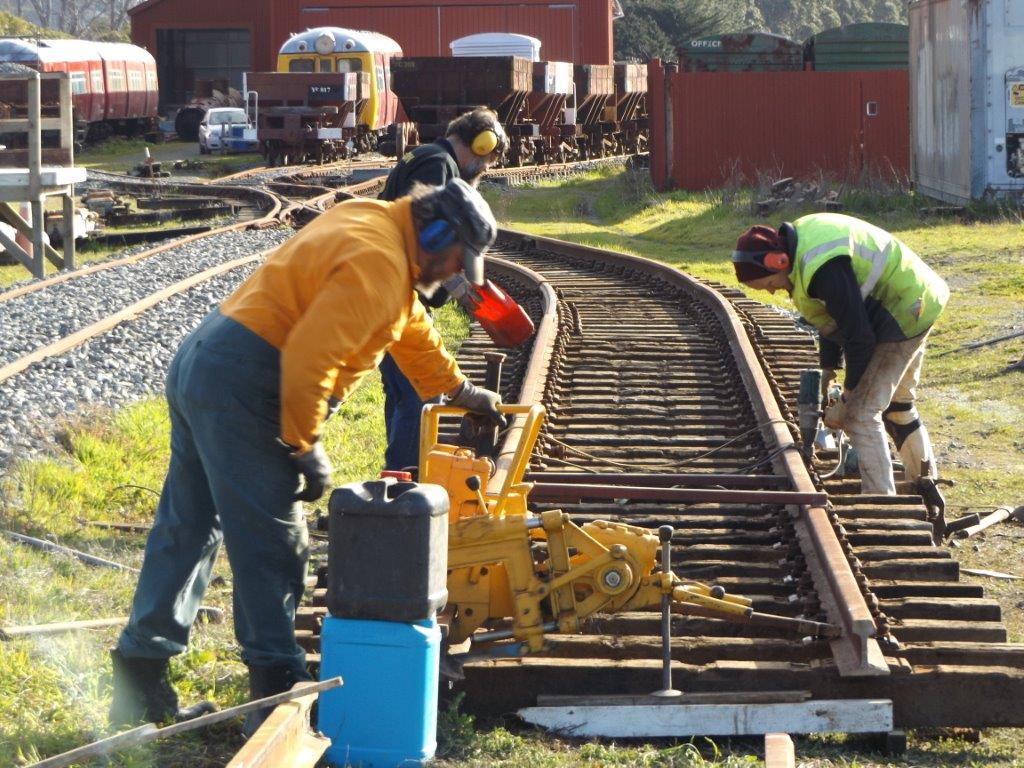
Loop track under construction in September 2015.
Mainline
Our mainline track has been extended to and past the pedestrian crossing / security gates, and another 150 metres extension is planned in the 2016-2017 year.
Rail vehicles
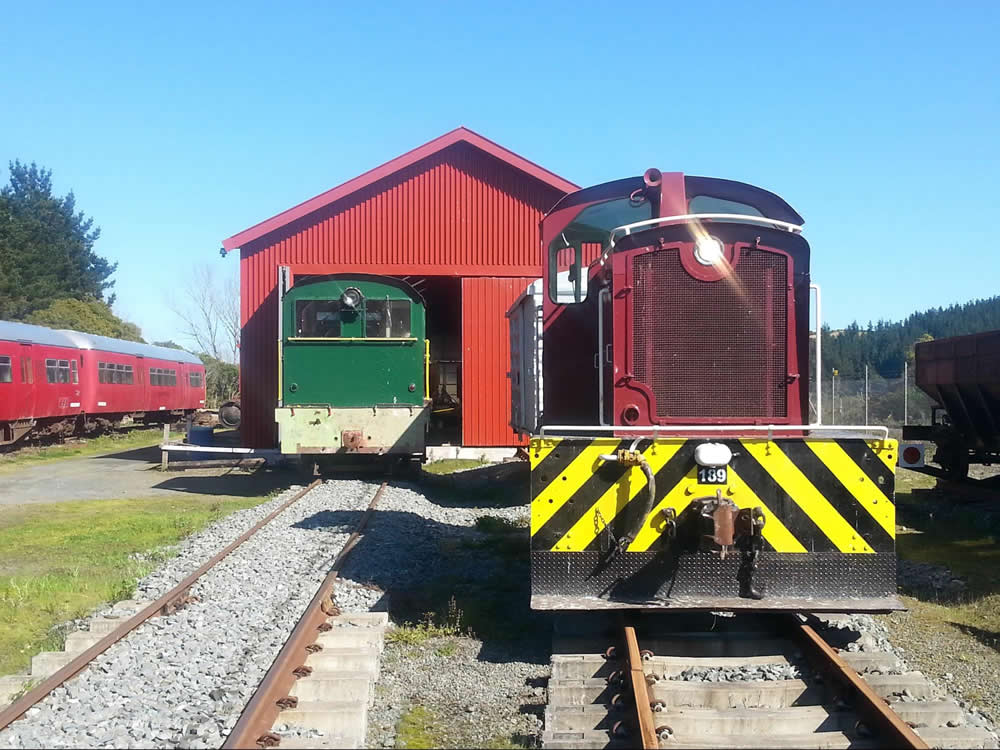
Ohai Railway Board #1, left, and Hillside Tr 189 shunt locomotives outside the rail vehicle shed in 2015.
The Trust has brought together a collection of rail vehicles, many of which will in future take passengers on their journey over the Rimutaka Incline Railway. Other vehicles, such as the fleet of ballast wagons, will be used to build and maintain the railway line. Business needs, heritage value, authenticity and mechanical condition are some of the factors that have been considered when acquiring carriages, wagons, and latterly, locomotives.
The carriage fleet totals seven, which when restored, will provide sufficient passenger accommodation for initial services. Carriage restoration work is pending completion of the rail vehicle shed and a thorough assessment of the fleet. A restoration plan will be developed, with priorities assigned based on carriage condition, anticipated traffic requirements and other factors. Restoration work will be hastened by facilities in our new workshop currently under construction.
Our shunting locomotive, three carriages and a wagon are now housed in the shed. Two 56-foot steel carriages and a guards van are currently stored outside in our secure compound, pending completion of the inspection pit facilities.
All operational rail vehicles are now located on permanent track.
Passenger Carriage A255
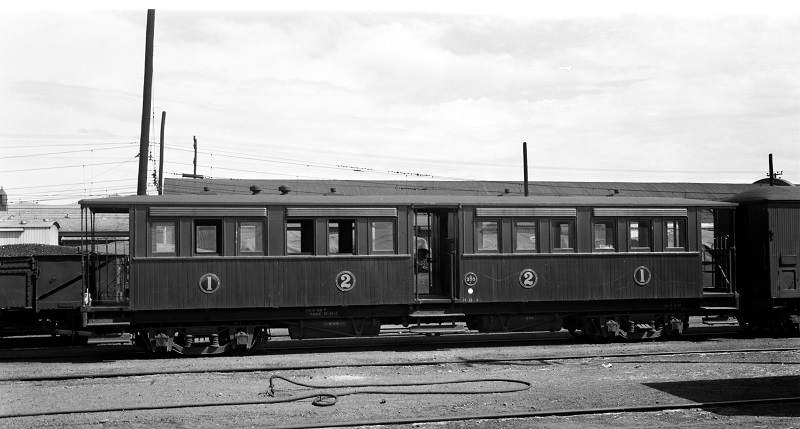
Photo: Gumdigger carriage A255 at Christchurch on 27 January 1950, near the end of its revenue-earning service. Photo: JAT Terry.
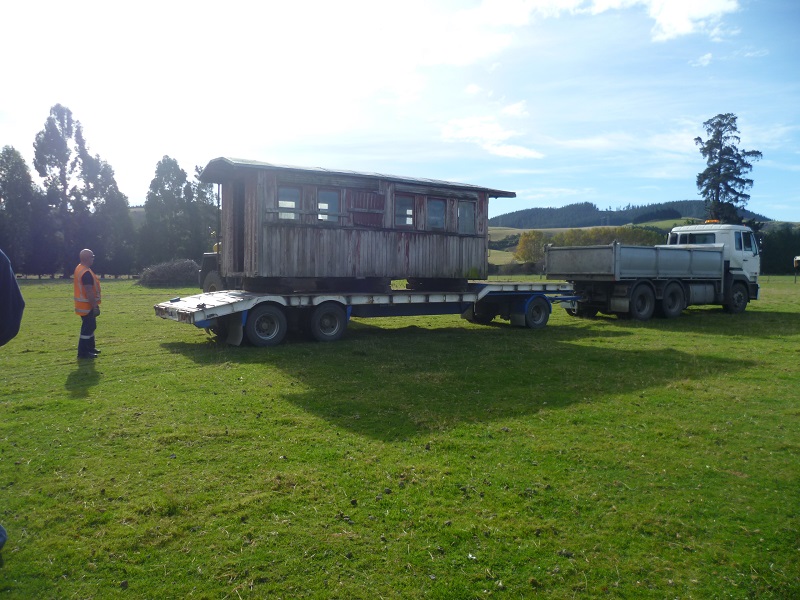
Half of carriage A255 being recovered from a farm on the Taieri Plains, Dunedin. Photo: Clark McCarthy.
Further major components required for our 1880s Gumdigger Carriage restoration project have been were made available to the Rimutaka Incline Railway, and approximately $4,000 was fundraised to transport the components from Dunedin to Upper Hutt.
In 2008 Wayne Haste donated a number of key components from carriage A189 along with an underframe – the start point for the project. The Trust stored these components for eventual use in a rebuilt Gumdigger carriage, pending completion of its storage and workshop facilities at Maymorn.
In late 2014 the Trust was offered one half of another Gumdigger carriage body - A255, which was located on a farm near Dunedin. This was a reasonably rare opportunity to obtain further Gumdigger carriage components, a major boost to the carriage project. The carriage body was required to be moved urgently and the Trust had to take swift action to remove it from the property to ensure that it was not demolished.
A255 was built in 1884 as a low roof centre balcony composite car. Gumdigger carriages were built between 1882-1887 in New Zealand Railway Workshops. This particular example is one of only two carriages of this style in existence. A255 was built at Addington Workshop, Christchurch, completed in September 1884. It was converted to second class accommodation in 1927, and written off at Addington 31 March 1952. It continued on in non-revenue service reclassified and renumbered as Ea 2568, finally written off on 12 September 1964. It was then was sold and relocated to a farm in Milton. The other main body component was located on another farm in the Dunedin area and has also been donated to the Trust for the project. The two halves of the carriage were reunited in Dunedin in May 2015, and traveled by rail from Dunedin to Wellington from 12-16 May 2015.
Work on A255 has focused on collecting the information required to record the history of the carriage and develop the conservation plan.
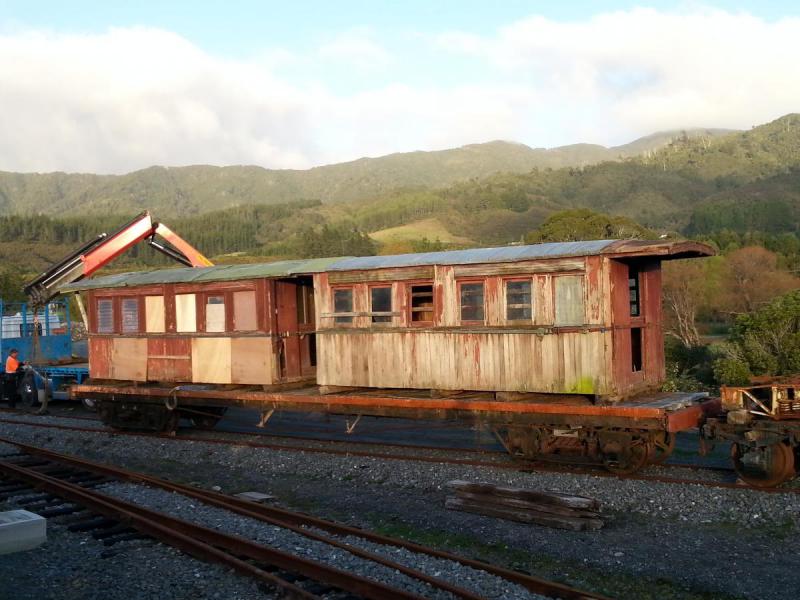
Both halves of A255 reunited at Maymorn, 19 May 2015.
Ohai Railway Board No.1
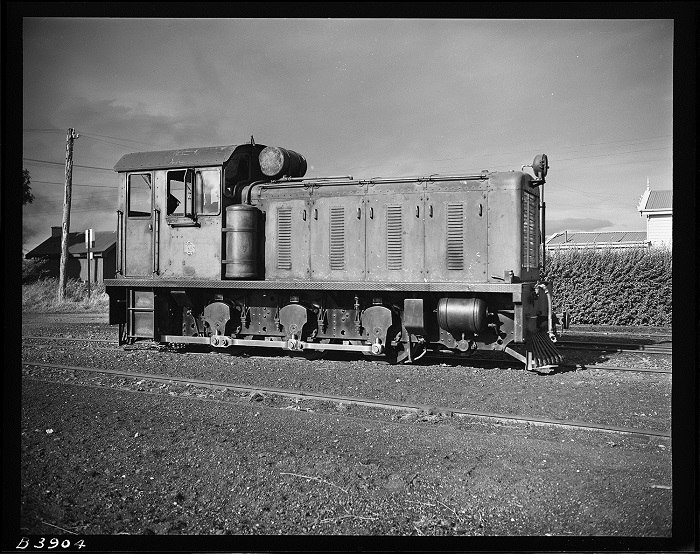
Ohai Railway Board No.1 at Ohai. Photo: [Archives Reference: AAVK 6390 W3493/180 B3904] Archives New Zealand The Department of Internal Affairs Te Tari Taiwhenua
The Trust has been working on the restoration of 1947 built Ohai Railway Board No.1. Ohai Railway Board No. 1 is the forerunner to the NZR Ds class of locomotive which were first put into service as heavy shunters in Wellington during 1949.
The Trust has developed a conservation plan is currently undertaking the fundraising and undertaking the work as detailed in the conservation plan. Once restored this locomotive will provide the Trust with a level of redundancy when major work is required on Tr189 as well as forming a key role in future railway construction activities and shunting work at Maymorn.
As Ohai Railway Board No.1 is fitted with train brakes it will give the Trust greater control over work trains and allow us to run demonstration passenger trains similar to those formerly run by the Ohai Railway Board.
Ballast wagons
Cleaning down and painting our ballast wagon fleet continued during the year. Yc817 was completed, and Yc 825 moved into the shed to facilitate this work. Long hours have been spent scraping down layers of flaking paint and grime, and preparing the steelwork for painting. Steady progress has been made, with a return to 1960s era livery and signwriting. A mechanical assessment has been made, air brake system cleaned down and checked. A return to service is expected early in the 2016-2017 year.
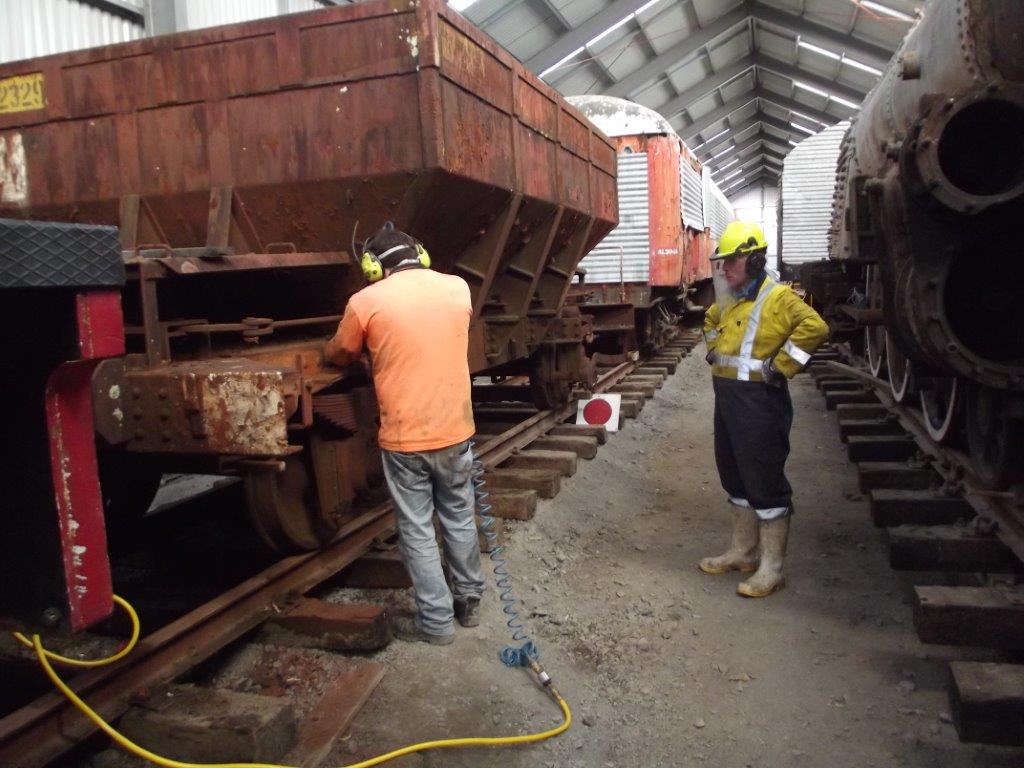
Ben and Bruce removing rust and old paint from ballast wagon Yc825, 25 July 2015.
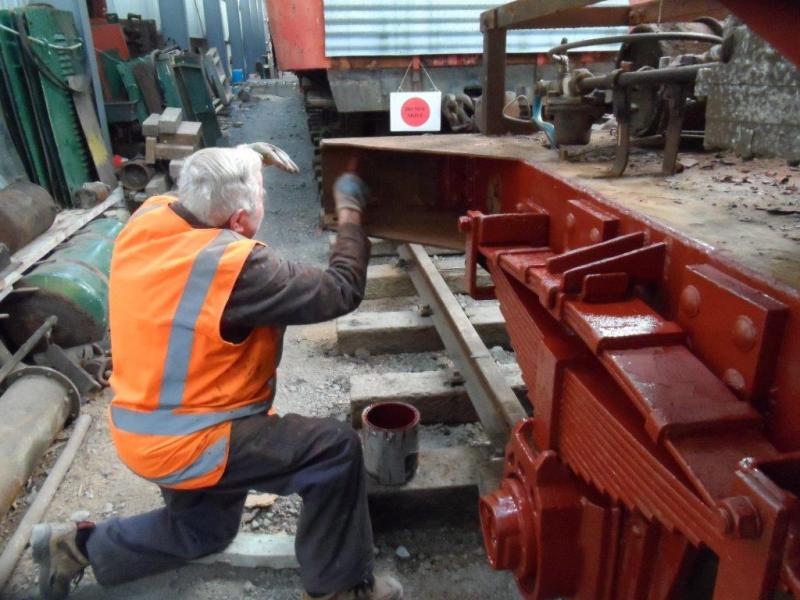
Trust member Ron Jones busy with painting ballast wagon Yc825.
Steam locomotive Wb299
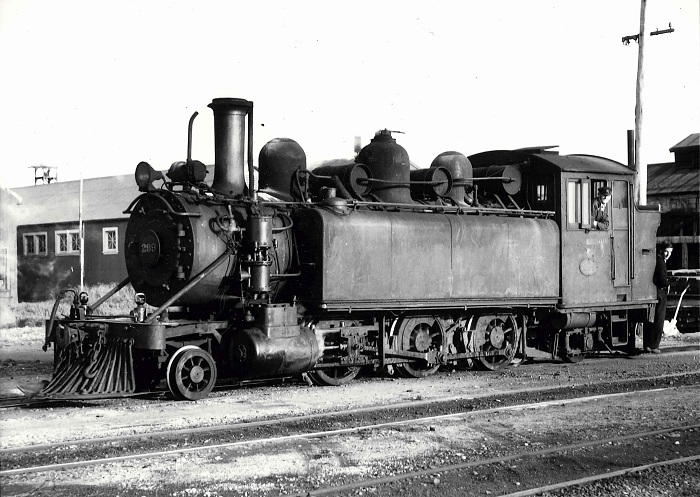
Photo: Wb 299 at Westport loco depot, c 1955. Photo: John Creber.
Wb 299 is one of two survivors of a class of twelve built in 1898 by Baldwin Locomotive Works, Philadelphia, U.S.A. The loco was based at Westport on the West Coast of the South Island, hauling coal trains from inland mines to the port. Two Wb class locomotives were originally based at Wellington, working trains to and from the Hutt Valley and Summit. Wb 292 and Wb 299 were salvaged from a dump site at Seddonville on the West Coast in 1989, having been dumped after withdrawal from service in 1958 and 1960. They have been in storage at Maymorn since 2008, and the frames of both locomotives are now inside the rail vehicle shed awaiting attention. CAD (Computer Aided Design) work has begun for the rebuilding of two Wb class Baldwin tank locomotives at the Rimutaka Incline Railway.
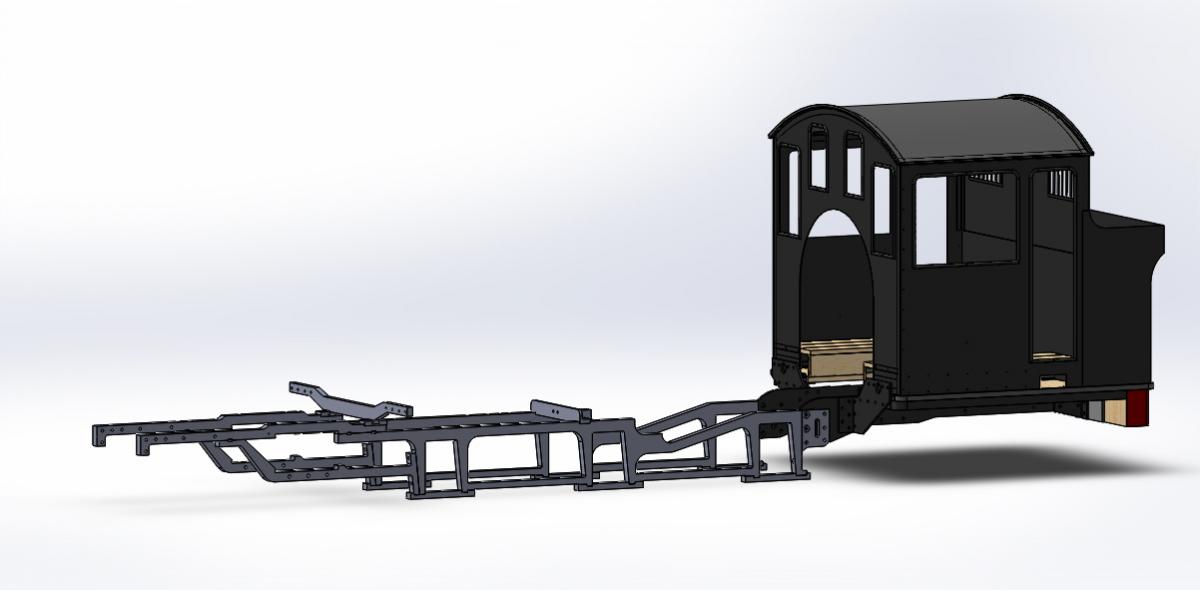
CAD drawing of locomotive frames with cab and bunker assemblies in place.
Trust members Ben Davidge and Hugh McCracken worked through the drawings available - both Baldwin and NZR, along with inspection and measurement of actual parts from the Wb locomotives. The cab has been picked as a starting point sub-assembly - essentially a number of sheet and angle items that are relatively approachable for funding and fabrication, and can be made independent of much of the rest of the locomotive.
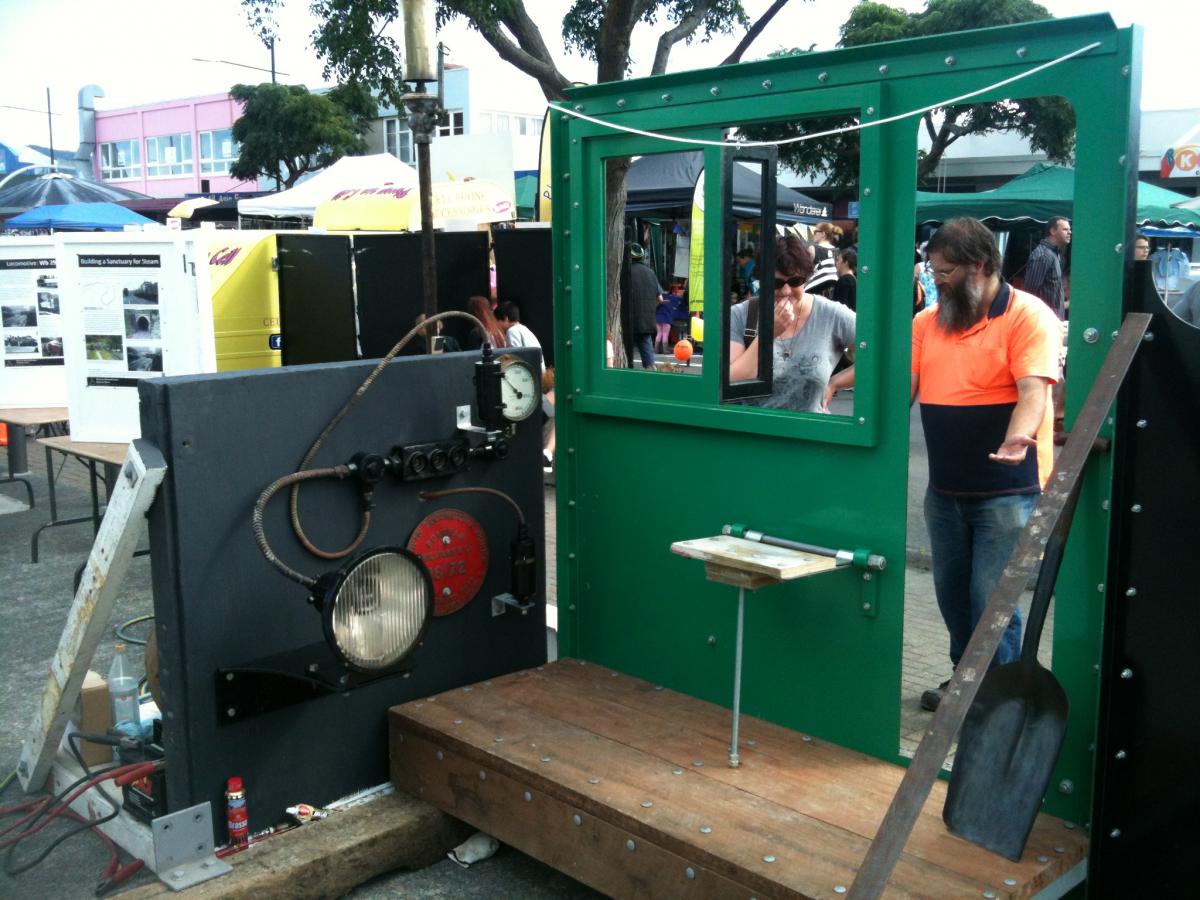
The driver’s side of the locomotive cab was fabricated, and displayed at a couple of key Upper Hutt community events - Upper Hutt Summer Carnival on 27 February 2016, and March Madness on 19 March 2016.
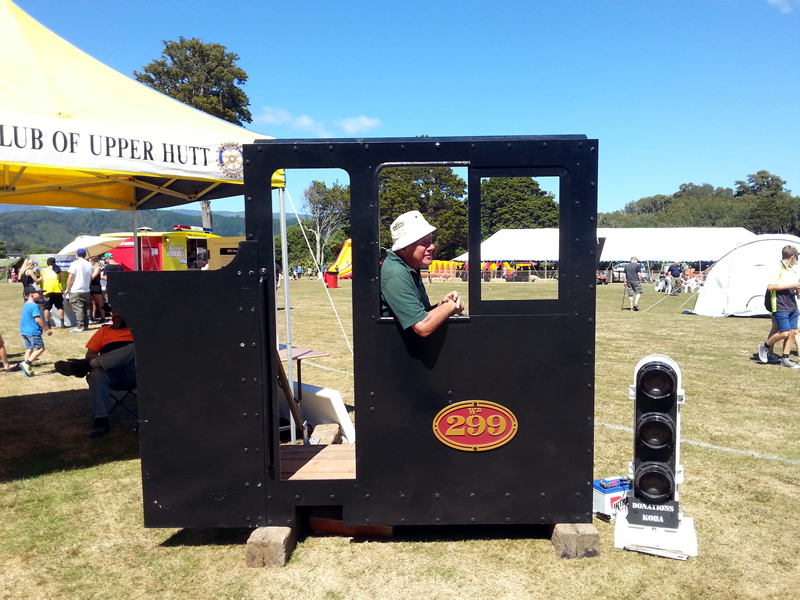
WG Bennett tries out the driver's seat of Wb 299 at Trentham Memorial Park during the 2015 Upper Hutt Summer Carnival.
| Original No | TMS No | Year outshopped | Where built | Arrival date at Maymorn | Notes |
|---|---|---|---|---|---|
| A255 | - | 1884 | NZR Addington Workshops | 19 May 2015 | non-operational |
| A189 | - | 1884 | NZR Workshops | 9 September 2009 | non-operational |
| A1896 | A56113 | 1941 | Otahuhu | 20 Dec 2005 | non-operational |
| A1914 | AL2044 | 1940 | Otahuhu | 21 Dec 2005 | non-operational |
| A1916 | A56247 | 1939 | Otahuhu | 7 Dec 2005 | non-operational |
| A1988 | A56750 | 1943 | Addington | 9 Dec 2005 | non-operational |
| A2000 | A56868 | 1940 | Addington | 8 Dec 2005 | non-operational |
| Aa1060 | - | 1909 | Petone | 4 May 2007 | non-operational |
| F605 | EA67715 | 1944 | Otahuhu | 23 Dec 2005 | non-operational |
| GM63 | ex-FM572 | 1977 | Mitsubishi, Japan | 3 April 2007 | non-operational |
| GM96 | ex-FM1070 | 1981 | Daewoo, Korea | 24 May 2006 | non-operational |
| GM97 | ex-FM1087 | 1981 | Daewoo, Korea | 20 May 2006 | non-operational |
| Kp1497 | KP6374 | 1961 | England | 27 July 2007 | operational |
| Kp2118 | KP12994 | 1965 | Mitsubishi, Japan | 9 August 2008 | operational |
| Kp2589 | KP17954 | 1966 | Mitsubishi, Japan | 8 August 2007 | non-operational |
| Kp3638 | ? | 1967 | Mitsubishi, Japan | 8 August 2007 | non-operational |
| Q1489 | Q8019 | 1953 | NZR | 23 July 2006 | Leased from Rail Heritage Trust |
| Q1534 | Q8407 | 1953 | NZR | 23 July 2006 | Leased from Rail Heritage Trust |
| Tr189 | TR937 | 1976 | Hillside | 30 July 2010 | non-operational |
| Wb292 | - | 1898 | Baldwin Locomotive Works #16172 | 9 August 2008 | non-operational |
| Wb299 | - | 1898 | Baldwin Locomotive Works #16175 | 9 August 2008 | non-operational |
| Wd356 | - | 1901 | Baldwin Locomotive Works #19260 | 23 July 2006 | non-operational |
| Yc726 | YC308 | 1959 | NZR | 5 September 2007 | operational |
| Yc760 | YC654 | 1960 | NZR | 16 October 2007 | operational |
| Yc782 | YC1083 | 1959-1961 | NZR | 5 September 2007 | operational |
| Yc789 | YC1175 | 1959-1961 | NZR | 5 September 2007 | operational |
| Yc795 | YC1238 | 1959-1961 | NZR | 6 September 2007 | operational |
| Yc817 | YC1486 | 1959-1961 | NZR | 6 September 2007 | operational |
| Yc825 | YC1578 | 1959-1961 | NZR | 30 August 2007 | operational |
| Yc845 | YC1768 | 1961 | NZR | 30 August 2007 | operational |
| Yc877 | YC2139 | 1961 | NZR | 19 November 2007 | operational |
| Yc878 | YC2145 | 1961 | NZR | 28 September 2007 | operational |
| Yc891 | YC2289 | 1961 | NZR | 28 September 2007 | operational |
| Yc895 | YC2329 | 1961 | NZR | 31 October 2007 | operational |
| Yc896 | YC2335 | 1961 | NZR | 30 August 2007 | operational |
Rail Vehicle Shed
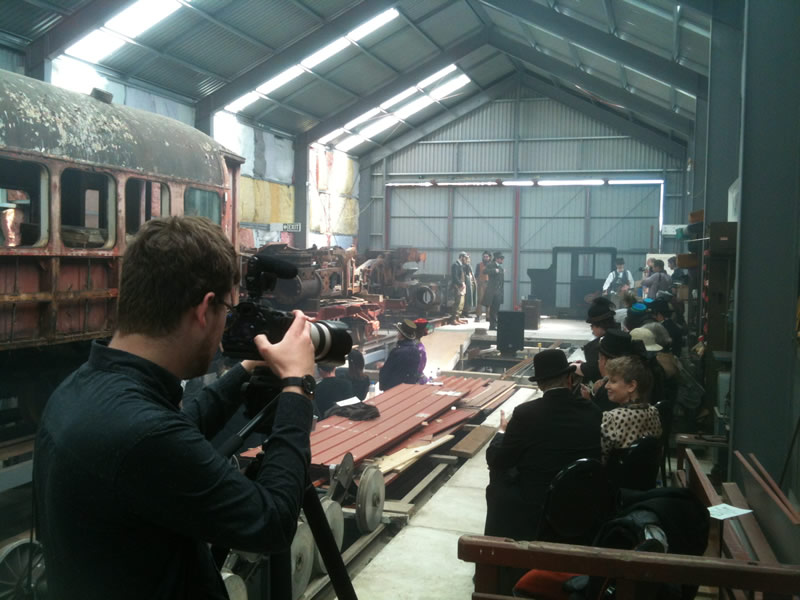
Steam punk wedding hosted within the rail vehicle shed, 24 October 2015
An 80-metre long, two-road rail vehicle shed has been constructed to securely store carriages, locomotives and other heritage rail vehicles, and to enable their restoration, maintenance and future operation. It will eventually be fitted out with inspection pits throughout much of its length and concrete floors. Construction of the 15x10-metre workshop at the Upper Hutt end is nearing completion, and inspection pit flooring and access stairs are well advanced.
Inspection pits on both roads are able to be used, and the external shell is complete aside from gutters. As noted elsewhere, three carriages, a wagon and a locomotive are now housed in the shed. Volunteers have also benefitted from the shelter afforded by the shed and an increasing amount of rail vehicle maintenance work is being undertaken within.
The list of tasks remaining to be tackled to complete the shed are now significantly reduced. These include:
- Completion of our inspection pits and associated floors
- Guttering and stormwater
- Security, lighting, power and other initial services
- Completion of workshop extension.
Workshop
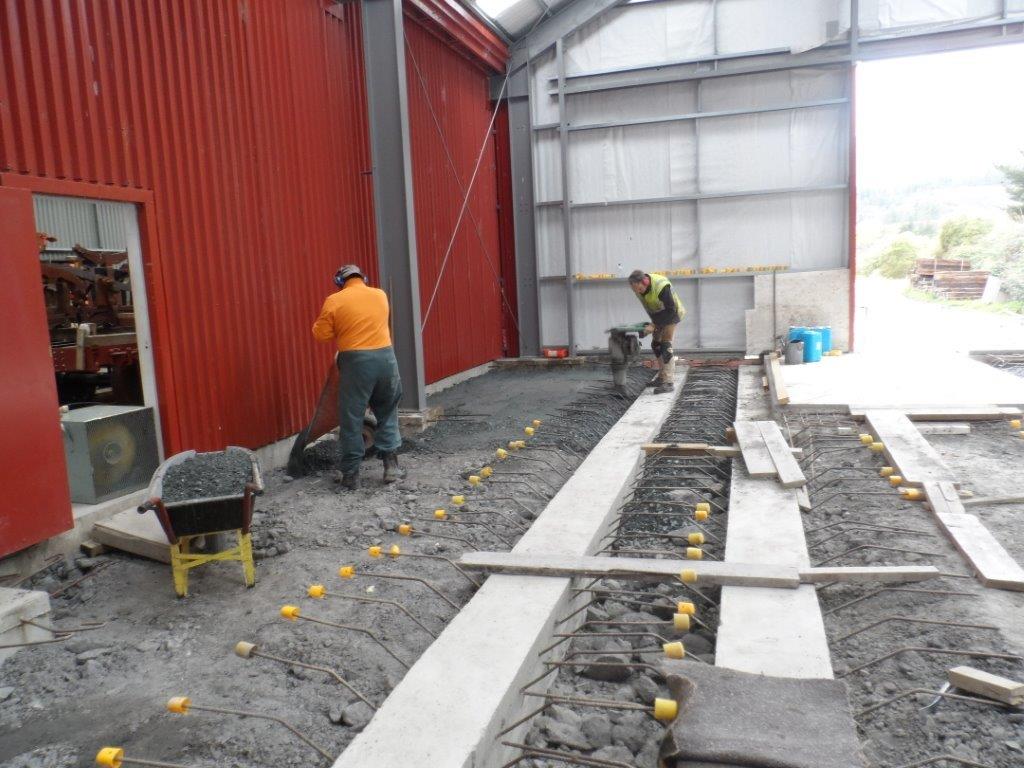
Placing and compacting fill around rail beams in preparation for floor slabs, 19 September 2015.
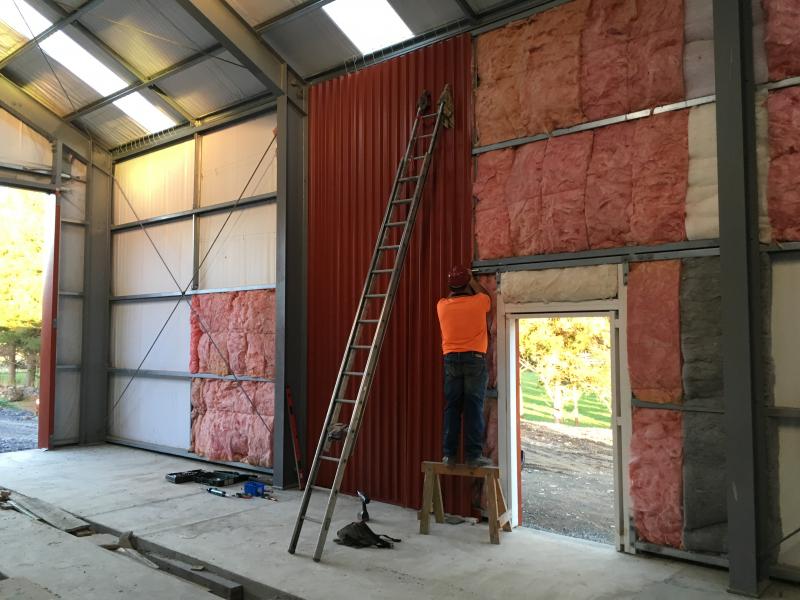
Lining interior workshop wall, floor slabs in place, 7 May 2016.
Work has continued on the workshop extension to the rail vehicle shed, following comletion of the portal frames and external cladding in the 2014-2015 year. Four concrete rail beams were cast in place to carry rails for both roads of the workshop, although only one road is proposed to have rail fitted at this stage. Floor slabs were completed in December 2015. Interior lining has started, along with fabrication of a heavy steel train door.
There will be space for heavy overhaul of a rail vehicle - locomotive, carriage or wagon on one road, with lathes, drill presses and other heavy machine tools in the remaining space.
Earthworks, landscaping and replanting
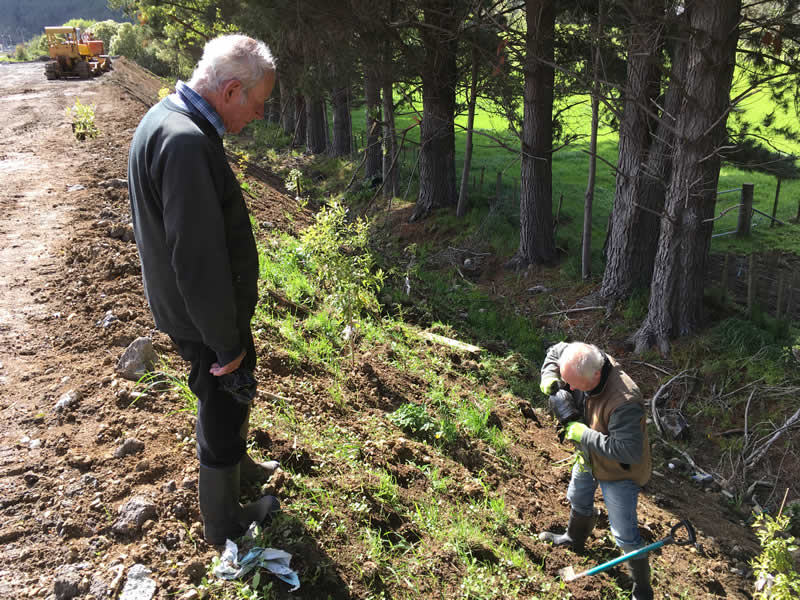
We are grateful for the continuing work of Bart Hogan and Graeme Bennett, who con tinue to look after landscaping and replanting work at the Maymorn site. The front entrance to the site has been kept in a very presentable condition through the year, with lawns mowed and weeds kept under control. To the Kaitoke end of the site an area has been planted with native trees and shrubs. Once the plantings take hold the area will be relatively low-maintenance. It should provide a small habitat for native birds — and provide screening and privacy for neighbouring properties. We plan to carry out further planting at the site as earthworks are completed. Landscaping either side of the pedestrian crossing have also been planted with native shrubs.
Education and promotion
Web presence
Web site
The web site at www.rimutaka-incline-railway.org.nz is the Trust’s primary mechanism for the dissemination of information, and research outputs. This continues to be of benefit to both membership and the general public.
The Trust has a Twitter profile: @rimutakaincline, with a history of more than 800 tweets, and more than 230 followers. In return, we follow and interact with close to a hundred other railways, locomotives, local businesses, local identities, politicians, railfans, Trust members and other people.
The Trust has a Facebook page: @RimutakaInclineRailwayHeritageTrust which is being used to promote operating days and restoration work.
Membership
Membership numbers total fifty — a reasonable number considering the hard work involved in developing our Maymorn site. We plan to continue to grow our membership base in 2016-2017. Membership has been available since the Trust’s incorporation in 2003.
Newsletters
Two newsletters were published during the year:
Newsletter 36- May 2015
Newsletter 37 - June 2016
The newsletters were sent electronically to members and stakeholders wherever possible, and put up on the Trust’s website a short time after publication.
Trust Board
Trustees
Ben Calcott — Chairperson
Hugh McCracken — Deputy Chairperson
Clark Simmonds — Secretary
Barry Timms — Trustee and Treasurer
Steve Porter — Trustee
Glenn Fitzgerald — Trustee
Ray Hampton — Trustee
Iain Palmer — Trustee
Board meetings
Formal Trust meetings were held regularly through the year, with Special Trust meetings called from time to time to consider specific or pressing matters.
Finance
Fundraising
During the year a number of funding applications were made to: Cossie Club of Upper Hutt and Rimutaka Trust. Amounts granted are listed in the financial statements.
We are also grateful for ongoing financial support gifted by the Rotary Club of Upper Hutt, funding a substantial portion of the purchase of shunting locomotive Tr189.
We are most grateful to Trust members and supporters who have generously donated funds and materials.
Acknowledgements
The work of the Rimutaka Incline Railway Heritage Trust would not be possible without the ongoing support of local, regional and central organisations, and of course, the hard work of many volunteers. Support comes in many different forms, including donations and grants, both financial and in-kind, pro-bono technical and professional support and volunteer activity. We would like to thank the following organisations and people for their support:
Strategic partners
The Trust gratefully acknowledges the support of Upper Hutt City Council.
Principal Sponsors and partners
The Trust would like to thank the following principal sponsors and partners for their support in this and previous years:
| NZ Lottery Grants Board | Protection of carriages and other rail vehicles through grant for rail vehicle shed |
|---|---|
| Rimutaka Charitable Trust | Continued support shown to the Trust, including significant funding towards the rail vehicle shed, carriage fleet and railway station design. |
| The Community Trust of Wellington | Protection of carriages and other rail vehicles through grant for rail vehicle shed. |
| Hurlstone Earthmoving Limited | Excavation of railway formation at Maymorn station. |
| Rotary Club of Upper Hutt | Continued support shown to the Trust, including transport of sleeping carriage Aa1060 to site, purchase and transport of historic water vats and substantial contribution to purchase of shunting locomotive Tr189. |
| KiwiRail | Donation of track materials for mainline and loop, Maymorn. |
| Holcim NZ Ltd | Donation of ballast for mainline and loop, Maymorn. |
| Baldwin Steam Trust | Lease of Baldwin steam locomotives dating from 1898 and 1901. |
| Pelorus Trust | Cladding for rail vehicle shed, Transport of ballast wagons to Maymorn |
|---|---|
| New Zealand Community Trust | Sponsorship of ballast wagons |
| Rail Heritage Trust of New Zealand | Ballast for mainline, loop and station throat: Maymorn station |
| Upper Hutt Lions Club | Transport of carriage bogies from Huntly to Maymorn |
| Ron Greenwood Environmental Trust | Native tree establishment projects at Maymorn and Summit. |
| Upper Hutt City Council | Assistance with building consent and building inspection fees for rail vehicle shed |
|---|---|
| Paino and Robertson | Legal advice |
| Dunning Thornton Consultants | Discounted engineering work associated with rail vehicle shed and workshop |
| KiwiRail Network | Donation and discounted rates for surplus track, signalling and maintenance equipment |
| Forest and Bird, Upper Hutt branch | Native tree establishment plantings at Maymorn |
| Chris Northmore | Use of light truck and hiab |
| John de Graaff | Assistance with concrete floor finishing in the rail vehicle shed. |
| Trust members | We are indebted to Trust members for their significant contribution of voluntary work and donations. |
Financial statements
Financial statements for the 2015-2016 year are available from our website at www.rimutaka-incline-railway.org.nz/about-us.
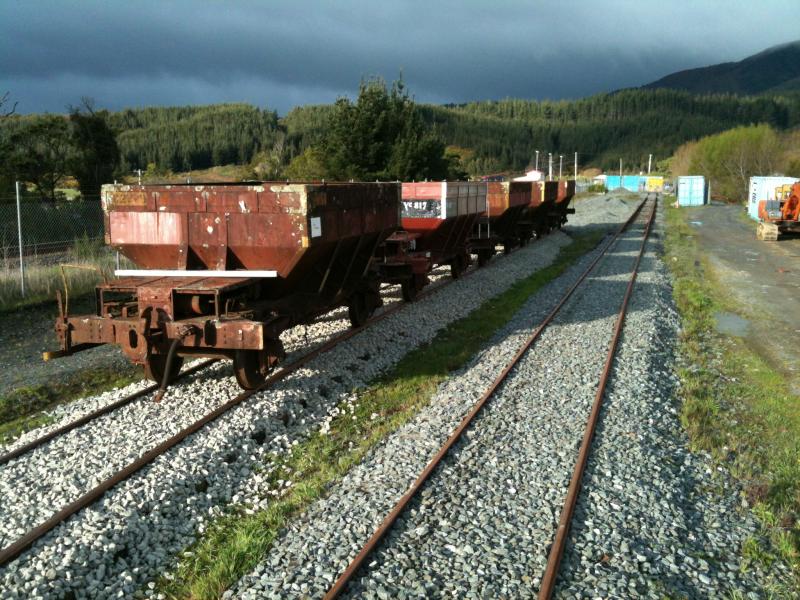
A view of the Maymorn station yard in September 2015, looking towards Kaitoke.
